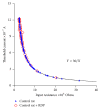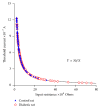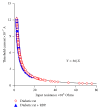The Actions of Lyophilized Apple Peel on the Electrical Activity and Organization of the Ventricular Syncytium of the Hearts of Diabetic Rats
- PMID: 26839897
- PMCID: PMC4709627
- DOI: 10.1155/2016/8178936
The Actions of Lyophilized Apple Peel on the Electrical Activity and Organization of the Ventricular Syncytium of the Hearts of Diabetic Rats
Abstract
This study was designed to examine the effects of lyophilized red delicious apple peel (RDP) on the action potentials (APs) and the input resistance-threshold current relationship. The experiments were performed on isolated papillary heart muscles from healthy male rats, healthy male rats treated with RDP, diabetic male rats, and diabetic male rats treated with RDP. The preparation was superfused with oxygenated Tyrode's solution at 37°C. The stimulation and the recording of the APs, the input resistance, and the threshold current were made using conventional electrophysiological methods. The RDP presented no significant effect in normal rats. Equivalent doses in diabetic rats reduced the APD and ARP. The relationship between input resistance and threshold current established an inverse correlation. The results indicate the following: (1) The functional structure of the cardiac ventricular syncytium in healthy rats is heterogeneous, in terms of input resistance and threshold current. Diabetes further accentuates the heterogeneity. (2) As a consequence, conduction block occurs and increases the possibility of reentrant arrhythmias. (3) These modifications in the ventricular syncytium, coupled with the increase in the ARP, are the adequate substrate so that, with diabetes, the heart becomes more arrhythmogenic. (4) RDP decreases the APD, the ARP, and most syncytium irregularity caused by diabetes.
Figures










Similar articles
-
Increased susceptibility to hypoxia of prolonged action potential duration in ventricular papillary muscles from diabetic rats.Diabetes. 1990 Dec;39(12):1485-9. doi: 10.2337/diab.39.12.1485. Diabetes. 1990. PMID: 2245875
-
Influence of calcium channel blocker treatment on the mechanical properties of diabetic rat myocardium.Acta Diabetol. 1996 Mar;33(1):7-14. doi: 10.1007/BF00571933. Acta Diabetol. 1996. PMID: 8777289
-
Inverse relation between input resistance and threshold current in canine cardiac syncytium.J Cardiovasc Electrophysiol. 2001 Mar;12(3):337-42. doi: 10.1046/j.1540-8167.2001.00337.x. J Cardiovasc Electrophysiol. 2001. PMID: 11291808
-
Musa paradisiaca L. leaf and fruit peel hydroethanolic extracts improved the lipid profile, glycemic index and oxidative stress in nicotinamide/streptozotocin-induced diabetic rats.Vet Med Sci. 2021 Mar;7(2):500-511. doi: 10.1002/vms3.389. Epub 2020 Dec 5. Vet Med Sci. 2021. PMID: 33277985 Free PMC article.
-
Electrophysiological changes in rat ventricular and atrial myocardium at different stages of experimental diabetes.Acta Physiol Scand. 1999 May;166(1):7-13. doi: 10.1046/j.1365-201x.1999.00538.x. Acta Physiol Scand. 1999. PMID: 10372973
References
-
- McGhie T. K., Hudault S., Lunken R. C. M., Christeller J. T. Apple peels, from seven cultivars, have lipase-inhibitory activity and contain numerous ursenoic acids as identified by LC-ESI-QTOF-HRMS. Journal of Agricultural and Food Chemistry. 2012;60(1):482–491. doi: 10.1021/jf203970j. - DOI - PubMed
Publication types
MeSH terms
Substances
LinkOut - more resources
Full Text Sources
Other Literature Sources
Research Materials
Miscellaneous

